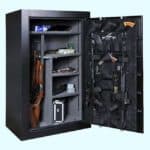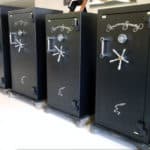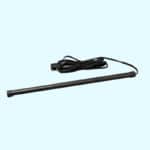There is no trick in how to pick the best gun safe, as there is a lot that has to be considered before making a choice.  Will it protect its contents from an intense house fire? Can it withstand an extended attack from burglars? What locking and bolting mechanisms is it built with? Will it hold an entire collection of firearms? Again, there’s a lot to consider, but it’s worth putting in the research. A reliable, stalwart security container can keep people honest, protect children from accessing the firearms, keep a valuable collection organized and assist with home defense.
Will it protect its contents from an intense house fire? Can it withstand an extended attack from burglars? What locking and bolting mechanisms is it built with? Will it hold an entire collection of firearms? Again, there’s a lot to consider, but it’s worth putting in the research. A reliable, stalwart security container can keep people honest, protect children from accessing the firearms, keep a valuable collection organized and assist with home defense.
How to Pick the Best Gun Safe
 There’s no way around it – the first time is the hardest when it comes to selecting a safe. There are multiple performance ratings associated with them, and the testing methods behind these ratings aren’t always clear. On top of that, new buyers tend to make some critical mistakes in the selection process, so here’s what to look for when picking a gun safe:
There’s no way around it – the first time is the hardest when it comes to selecting a safe. There are multiple performance ratings associated with them, and the testing methods behind these ratings aren’t always clear. On top of that, new buyers tend to make some critical mistakes in the selection process, so here’s what to look for when picking a gun safe:
- Always go bigger – One of the most common issues that buyers run into is running out of space for their firearms. Although manufacturers list how many guns their containers can hold, this is typically not a realistic number. If the safe is filled up to capacity, then it’s going to be a tight fit. Getting firearms in or out may lead to scratches and dings, and will just be a frustrating thing to deal with overall. Also, those capacity figures don’t normally take into account firearms that have attachments on them, like scopes. It is much easier to buy a safe that’s a bit bigger than needed and fill it up over time than it is to replace it with a larger one. It may cost a bit more upfront, but it will be worth it. Collectors collect, after all.
 Look for UL or ETL Ratings – UL and ETL ratings are the most respected names in the product testing and certification business. Both employ elite teams of safecrackers and can put containers through rigorous fire testing. Terms like “fireproof” don’t mean much if there isn’t UL or ETL backing behind them, so don’t get taken in by them. Some manufacturers do their own in-house testing instead of sending their containers off to UL or ETL, and these tests may be doctored to produce favorable results. UL and ETL are trusted sources and produce fair and honest listings. During a UL test, for example, the container is placed in a furnace that is heated up to 1700 degrees Fahrenheit for an hour, or up to 1850 degrees Fahrenheit for two hours. This is much hotter than a standard house fire, which usually tops out at around 1200 degrees. During the test, a sensor inside the container reports the interior temperature, and to pass the test, the interior temperature must remain at or below 350 degrees Fahrenheit throughout the duration of the testing. Now, 350 degrees is still extremely hot, and is too hot to safely store devices that hold data, or even some firearms that are made from certain synthetic materials, but it will keep firearms, wood and paper from turning into a pile of ash.
Look for UL or ETL Ratings – UL and ETL ratings are the most respected names in the product testing and certification business. Both employ elite teams of safecrackers and can put containers through rigorous fire testing. Terms like “fireproof” don’t mean much if there isn’t UL or ETL backing behind them, so don’t get taken in by them. Some manufacturers do their own in-house testing instead of sending their containers off to UL or ETL, and these tests may be doctored to produce favorable results. UL and ETL are trusted sources and produce fair and honest listings. During a UL test, for example, the container is placed in a furnace that is heated up to 1700 degrees Fahrenheit for an hour, or up to 1850 degrees Fahrenheit for two hours. This is much hotter than a standard house fire, which usually tops out at around 1200 degrees. During the test, a sensor inside the container reports the interior temperature, and to pass the test, the interior temperature must remain at or below 350 degrees Fahrenheit throughout the duration of the testing. Now, 350 degrees is still extremely hot, and is too hot to safely store devices that hold data, or even some firearms that are made from certain synthetic materials, but it will keep firearms, wood and paper from turning into a pile of ash.- Know what good security looks like – Picking the best gun safe begins with choosing the safe that offers the best combination of affordability and security. Here, there is a little give and take, but there is a baseline for security that new buyers should keep in mind. Locks come in several varieties, including mechanical, biometric, electronic and plain old key locks. Key locks are too easily defeated to be used as a form of security. Biometric are secure, but they don’t have quite the reliability that mechanical and electronic locks have. And between mechanical and electric, there really isn’t a clear-cut winner. Owners can access electronic locks much faster on average, and many consider mechanical locks to be the most reliable. Some containers are built with both, in case the electronic lock shorts out for some reason.
- Buyers should look for safes that come with both live bolts and dead bolts – Live bolts and dead bolts are typically made with durable steel cylinders, and nothing beats steel when it comes to withstanding force. Live bolts move with the handle as the container is unlocked, while dead bolts are built into the hinge side of the door, resisting attempts to pry the door open. The most secure safes will have both, and they should be at least 7/8’’ thick to provide adequate protection. Of course, the container’s door and walls should be reinforced with additional plate steel, as this will prevent attempts to drill into the container. Look for UL TL ratings to determine the security level. In general, a UL RSC rating will do its job in resisting forced entry. UL crackers have access to an impressive array of mechanical and electrical tools, so if a container can resist their efforts for five minutes (the minimum for a RSC rating), then it’s safe to assume that the typical burglar will need much more than that.
 Moisture is the enemy – As every firearm collector knows, moisture and guns don’t mix. With excess moisture comes rust, and rust is a big problem. Fortunately, many modern models are ready to be fitted with dehumidifier accessories. These dehumidifiers rely on desiccant materials to absorb moisture out of the air, so they run quietly and only need occasional recharging. With a desiccant dehumidifier, moisture is not a concern. Some containers use a light instead for dehumidifying, and though it’s not as efficient, it can help to a degree. Lights, of course, also help owners see their firearms, which may be critical if they are needed for home defense.
Moisture is the enemy – As every firearm collector knows, moisture and guns don’t mix. With excess moisture comes rust, and rust is a big problem. Fortunately, many modern models are ready to be fitted with dehumidifier accessories. These dehumidifiers rely on desiccant materials to absorb moisture out of the air, so they run quietly and only need occasional recharging. With a desiccant dehumidifier, moisture is not a concern. Some containers use a light instead for dehumidifying, and though it’s not as efficient, it can help to a degree. Lights, of course, also help owners see their firearms, which may be critical if they are needed for home defense.- Be careful when storing ammo – In addition to taking up more space, ammunition may leak gases as their primers break down. When the gases are trapped inside, they can accelerate corrosion and cause damage to both the firearms and the container over time. For this reason, many collectors elect to store their ammunition in a different area.
Most safes can store both long rifles and handguns, with shelving designed to accommodate both. Again, though, keep in mind the extra space that rifles with scopes and other attachments will require, and factor that in before making a purchase.
While there’s no single best approach in how to pick the best gun safe, sticking to these standards will help a buyer make the best decision. In short, there should be no compromise with security, and as long as the safe comes from a reputable manufacturer, compromise should not be necessary.

